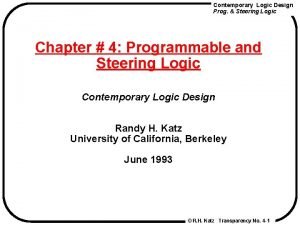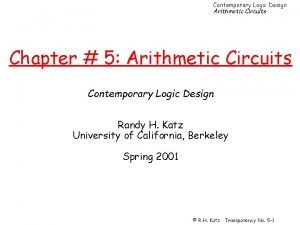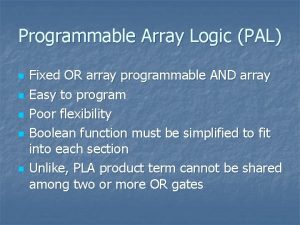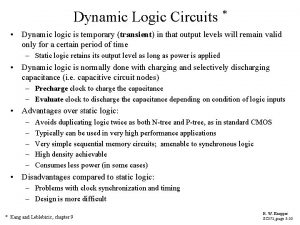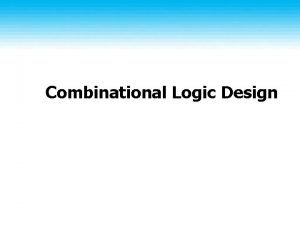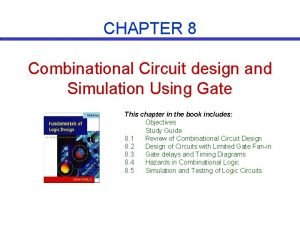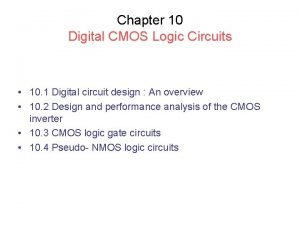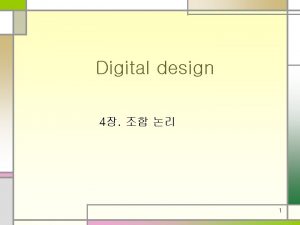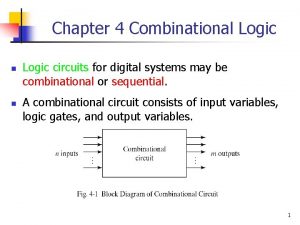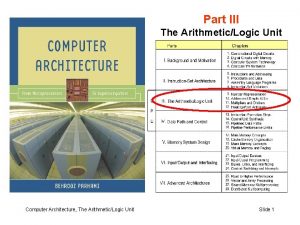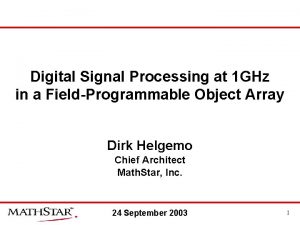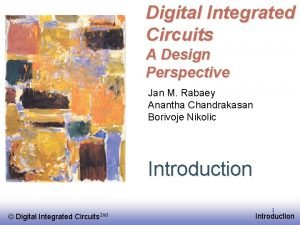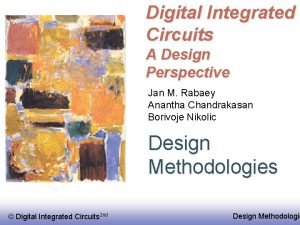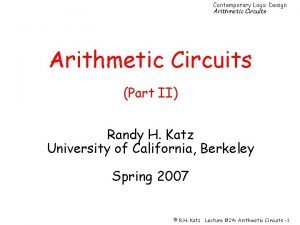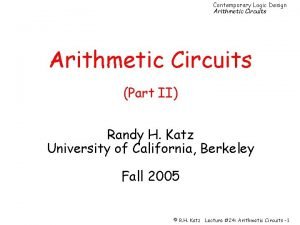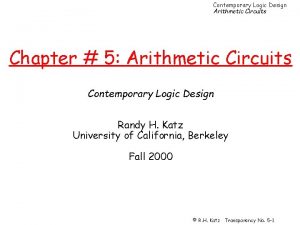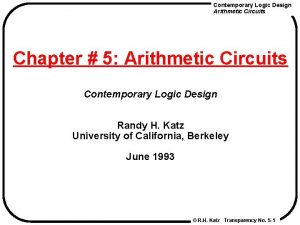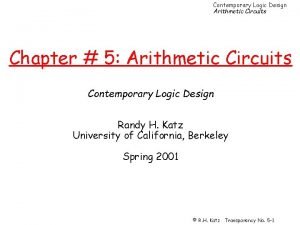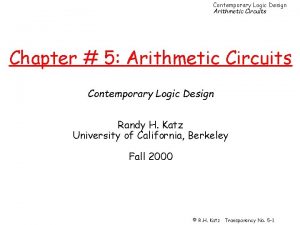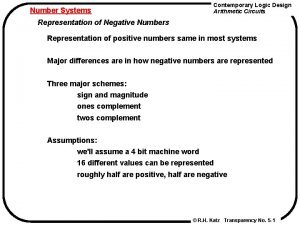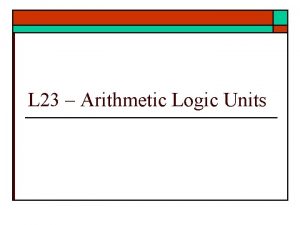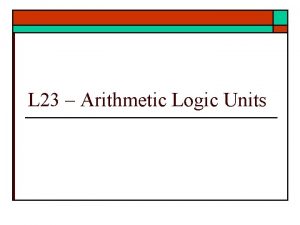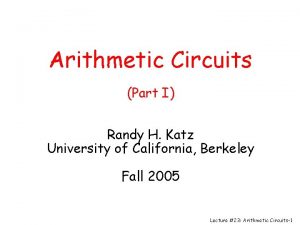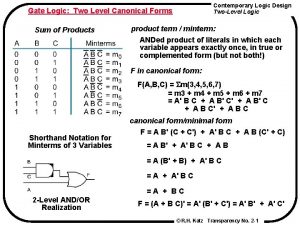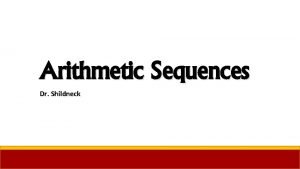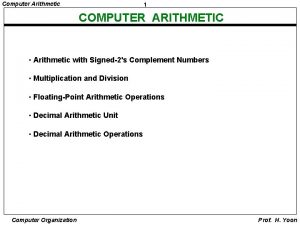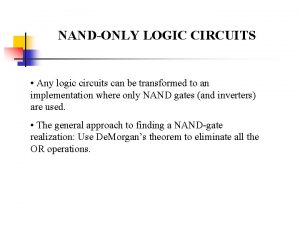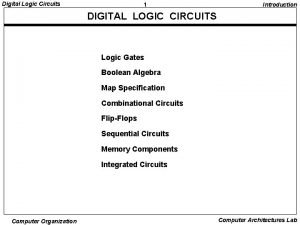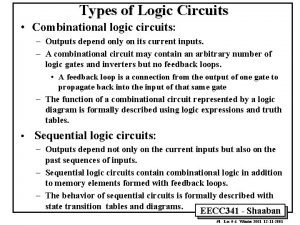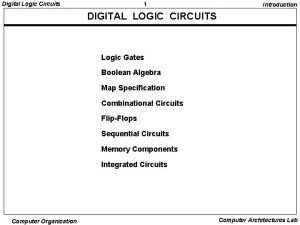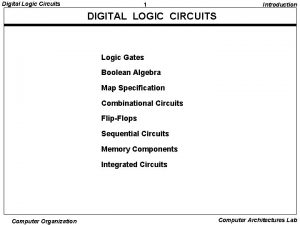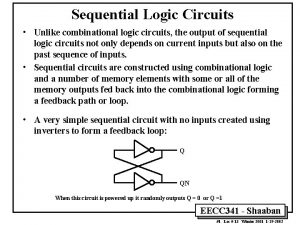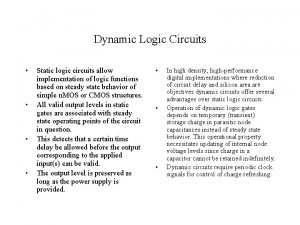Contemporary Logic Design Arithmetic Circuits Part II Randy

































- Slides: 33

Contemporary Logic Design Arithmetic Circuits (Part II) Randy H. Katz University of California, Berkeley Spring 2007 © R. H. Katz Lecture #24: Arithmetic Circuits -1

Contemporary Logic Design Arithmetic Circuits Overview • BCD Circuits • Combinational Multiplier Circuit • Design Case Study: 8 Bit Multiplier • Sequential Multiplier Circuit © R. H. Katz Lecture #24: Arithmetic Circuits -2

Contemporary Logic Design Arithmetic Circuits BCD Addition BCD Number Representation Decimal digits 0 thru 9 represented as 0000 thru 1001 in binary Addition: 5 = 0101 3 = 0011 8 = 1000 = 8 1101 = 13! Problem when digit sum exceeds 9 Solution: add 6 (0110) if sum exceeds 9! 5 = 0101 9 = 1001 8 = 1000 7 = 0111 1101 6 = 0110 1 0011 = 1 3 in BCD 1 0000 = 16 in binary 6 = 0110 1 0110 = 1 6 in BCD © R. H. Katz Lecture #24: Arithmetic Circuits -3

Contemporary Logic Design Arithmetic Circuits BCD Addition Adder Design A 3 B 3 CO FA CI S A 1 11 XX A 2 1 X 1 X A 2 B 2 CO FA S 3 B 1 CO FA CI A 0 CI CO FA S S S 2 S 1 B 0 CO FA S S CO FA Cout CI A 1 CI Cin S CI 0 S 0 Add 0110 to sum whenever it exceeds 1001 (11 XX or 1 X 1 X) © R. H. Katz Lecture #24: Arithmetic Circuits -4

Contemporary Logic Design Arithmetic Circuits Combinational Multiplier Basic Concept multiplicand multiplier Partial products 1101 (13) product of 2 4 -bit numbers is an 8 -bit number * 1011 (11) 1101 0000 1101 10001111 (143) © R. H. Katz Lecture #24: Arithmetic Circuits -5

Contemporary Logic Design Arithmetic Circuits Combinational Multiplier Partial Product Accumulation S 7 A 3 A 2 A 1 A 0 B 3 B 2 B 1 B 0 A 3 B 0 A 2 B 0 A 1 B 0 A 0 B 0 A 3 B 1 A 2 B 1 A 1 B 1 A 0 B 1 A 3 B 2 A 2 B 2 A 1 B 2 A 0 B 2 A 3 B 3 A 2 B 3 A 1 B 3 A 0 B 3 S 6 S 5 S 4 S 3 S 2 S 1 S 0 © R. H. Katz Lecture #24: Arithmetic Circuits -6

Contemporary Logic Design Arithmetic Circuits Combinational Multiplier Partial Product Accumulation A 3 B 3 A 3 B 2 A 2 B 3 A 3 B 1 A 2 B 2 A 1 B 3 A 3 B 0 A 2 B 1 A 1 B 2 A 0 B 3 A 2 B 0 A 1 B 1 A 0 B 2 A 0 B 1 A 1 B 0 A 0 B 0 FA FA S 7 HA FA FA HA FA S 6 S 5 S 4 S 3 HA HA FA S 2 S 1 S 0 Note use of parallel carry-outs to form higher order sums 12 Adders, if full adders, this is 6 gates each = 72 gates 16 gates form the partial products total = 88 gates! © R. H. Katz Lecture #24: Arithmetic Circuits -7

Contemporary Logic Design Arithmetic Circuits Combinational Multiplier Another Representation of the Circuit Sum In X Building block: full adder + and Y FA Cout A B CO CI S Cin Sum Out A 3 B 0 A 2 A 3 B 0 C B 1 S A 3 B 1 C B 2 S A 3 B 2 C B 3 C S S S A 1 B 3 A 0 B 3 S S P 5 P 4 P 3 A 0 B 2 C A 2 B 3 P 6 S A 1 B 2 C A 1 B 0 C S A 1 B 1 C A 3 B 3 C P 7 S S A 2 B 1 A 2 B 2 C A 2 B 0 C A 0 A 1 A 0 B 1 C A 0 B 0 C 0 S 0 S 0 P 2 4 x 4 array of building blocks P 1 P 0 © R. H. Katz Lecture #24: Arithmetic Circuits -8

Contemporary Logic Design Arithmetic Circuits Case Study: 8 x 8 Multiplier Problem Decomposition How to implement 8 x 8 multiply in terms of 4 x 4 multiplies? A 7 -4 A 3 -0 * B 7 -4 B 3 -0 A 3 -0 * B 3 -0 8 bit products A 7 -4 * B 3 -0 = PP 1 A 3 -0 * B 7 -4 = PP 2 A 7 -4 * B 7 -4 P 15 -12 = PP 0 P 11 -8 = PP 3 P 7 -4 P 3 -0 = PP 0 3 -0 P 7 -4 = PP 0 + PP 1 + PP 2 + Carry-in 3 -0 3 -0 P 11 -8 = PP 1 + PP 2 + PP 3 + Carry-in 7 -4 3 -0 P 15 -12 = PP 3 + Carry-in 7 -4 © R. H. Katz Lecture #24: Arithmetic Circuits -10

Case Study: 8 x 8 Multiplier Calculation of Partial Products Contemporary Logic Design Arithmetic Circuits Use 4 4 x 4 multipliers to create the 4 partial products © R. H. Katz Lecture #24: Arithmetic Circuits -11

Contemporary Logic Design Arithmetic Circuits Case Study: 8 x 8 Multiplier Three-At-A-Time Adder Clever use of the Carry Inputs Sum A[3 -0], B[3 -0], C[3 -0]: Two Level Full Adder Circuit Note: Carry lookahead schemes also possible! © R. H. Katz Lecture #24: Arithmetic Circuits -12

Contemporary Logic Design Arithmetic Circuits Case Study: 8 x 8 Multiplier Three-At-A-Time Adder with TTL Components Full Adder 4 -bit ALU/Adder Full Adders (2 per package) Standard ALU configured as 4 -bit cascaded adder (with internal carry lookahead) Note the off-set in the outputs © R. H. Katz Lecture #24: Arithmetic Circuits -13

Case Study: 8 x 8 Multiplier Accumulation of Partial Products FA 4 -bit ALU/Adder FA FA FA 4 -bit ALU/Adder Contemporary Logic Design Arithmetic Circuits FA FA 4 -bit ALU/Adder Just a case of cascaded three-at-a-time adders! © R. H. Katz Lecture #24: Arithmetic Circuits -14

Contemporary Logic Design Arithmetic Circuits Case Study: 8 x 8 Multiplier The Complete System (Actual TTL packages) © R. H. Katz Lecture #24: Arithmetic Circuits -15

Case Study: 8 x 8 Multiplier Package Count and Performance Contemporary Logic Design Arithmetic Circuits 4 74284/74285 pairs = 8 packages 4 74183, 3 74181, 1 74182 = 8 packages 16 packages total Partial product calculation (74284/285) = 40 ns typ, 60 ns max Intermediate sums (74183) = 9 ns/20 ns = 15 ns average, 33 ns max Second stage sums w/carry lookahead 74 LS 181: carry G and P = 20 ns typ, 30 ns max 74182: second level carries = 13 ns typ, 22 ns max 74 LS 181: formations of sums = 15 ns typ, 26 ns max 103 ns typ, 171 ns max © R. H. Katz Lecture #24: Arithmetic Circuits -16

Contemporary Logic Design Arithmetic Circuits Sequential Multiplier • 4 -Bit Multiplier Example: 3 x 4 = 12 – Four cycles to completion Cycle Multiplier Multiplicand Product Initialize 0011 0000 0100 0000 Cycle 0, Multiplier[0]=1 0000 1000 0100 Cycle 1, Multiplier[0]=1 0000 1100 Cycle 2, Multiplier[0]=0 0000 0010 0000 1100 Cycle 3, Multiplier[0]=0 0000 0100 0000 1100 Product = 0 For i = 0 to 3 do If Multiplier[0] = 1 then Product = Product + Multiplicand Shift right the Multiplier Shift left the Multiplicand © R. H. Katz Lecture #24: Arithmetic Circuits -17

Contemporary Logic Design Arithmetic Circuits Sequential Multiplier • Datapath and Control Block Diagram – External load signals for Multiplier and Multiplicand – Low order bit of multiplier: if 0, shift; if 1, shift and add 8 Load 1 Multiplier ‘ 0’ 8 Digit Clock 8 Multiplicand 16 ‘ 0’ Start Digit Load 2 Shift Control 16 Accumulator 16 Product Shift Clear Load 3 16 © R. H. Katz Lecture #24: Arithmetic Circuits -18

Contemporary Logic Design Arithmetic Circuits Sequential Multiplier • State Diagram – One state for each bit Reset Start’ Idle Start/Clear S 0 S 1 S 2 S 3 S 4 S 5 S 6 S 7 Digit/Load 3, Shift Digit’/Shift Digit/Load 3, Shift Digit’/Shift © R. H. Katz Lecture #24: Arithmetic Circuits -19

Contemporary Logic Design Arithmetic Circuits Sequential Multiplier • Control Timing Behavior Clk State Idle S 0 S 1 S 2 S 3 S 4 S 5 S 6 S 7 Digit 0 Digit 1 Digit 2 Digit 3 Digit 4 Digit 5 Digit 6 Digit 7 Idle Start Clear Load Shift © R. H. Katz Lecture #24: Arithmetic Circuits -20

Contemporary Logic Design Arithmetic Circuits Sequential Multiplier • Slightly Revised Block Diagram – If multiplier low order bit is 0 than assert 0 into accumulator – Else pass multiplicand through to accumulator – Simplifies the control! 8 Load 1 Multiplier ‘ 0’ 8 8 Multiplicand 16 Pass or Zero Digit Load 2 ‘ 0’ Clock Start Load 3 -Shift Pass/Zero’ Control 16 16 Accumulator 16 Product Clear Load 3 -Shift Clear 16 © R. H. Katz Lecture #24: Arithmetic Circuits -21

Sequential Multiplier • Revised State Diagram – Fewer control outputs! Contemporary Logic Design Arithmetic Circuits Reset Idle Start’ Start/Clear S 0 S 1 S 2 S 3 S 4 S 5 S 6 S 7 Load 3 -Shift Load 3 -Shift © R. H. Katz Lecture #24: Arithmetic Circuits -22

Contemporary Logic Design Arithmetic Circuits Sequential Multiplier • Symbolic/Encoded State Transition Table – State assignment chosen as follows: » Idle state set to 0000, i. e. , START resets the state FFs » States S 0 to S 7 set to 1000 to 1111, easy to implement as a counter Current Idle S 0 S 1 S 2 S 3 S 4 S 5 S 6 S 7 State Start 0000 0 0000 1 1000 1001 1010 1011 1100 1101 1110 1111 - Next State Clear Load 3 -Shift 0000 Idle 0 0 1000 S 0 1001 S 1 0 1 1010 S 2 0 1 1011 S 3 0 1 1100 S 4 0 1 1101 S 5 0 1 1110 S 6 0 1 1111 S 7 0 1 0000 Idle 0 1 © R. H. Katz Lecture #24: Arithmetic Circuits -23

Booth Multiplier Contemporary Logic Design Arithmetic Circuits Searching for ways to speed up the basic multiply step • Tricky encoding scheme to reduce the number of stages in a binary multiplier • Considers two bits at a time rather than one—this cuts the number of multiplier steps in half • Each step is slightly more complex compared to the simple multiplier, but is almost as fast as the basic multiplier stage that it replaces © R. H. Katz Lecture #24: Arithmetic Circuits -24

Contemporary Logic Design Arithmetic Circuits Alternative Multiply Hardware • 32 -bit Multiplicand reg, 32 -bit ALU, 64 -bit Product reg, (0 -bit Multiplier reg) • Rather than shift multiplier right and multiplicand left, we can shift BOTH the product and the multiplier to the right … Multiplicand 32 bits 32 -bit ALU Shift Right Product (Multiplier) 64 bits Write Control © R. H. Katz Lecture #24: Arithmetic Circuits -25

Multiply Control Start Multiplicand Product 0010 0000 0011 Product 0 = 1 1. Test Product 0 Contemporary Logic Design Arithmetic Circuits Product 0 = 0 1 a. Add multiplicand to the left half of product & place the result in the left half of Product register 2. Shift the Product register right 1 bit. 32 nd repetition? No: < 32 repetitions Yes: 32 repetitions Done © R. H. Katz Lecture #24: Arithmetic Circuits -26

Motivation for Booth’s Algorithm Contemporary Logic Design Arithmetic Circuits • Example 2 x 6 = 0010 x 0110: 0010 x 0110 + 0000 shift (0 in multiplier) + 0010 add (1 in multiplier) + 0000 shift (0 in multiplier) 00001100 • If ALU can subtract as well as add, get same result as follows: 6 = – 2 + 8 0110 = – 00010 + 01000 = 11110 + 01000 • For example 0010 x 0110 0000 shift (0 in multiplier) – 0010 sub(first 1 in multiplier) 0000 shift (mid string of 1 s) + 0010 add (prior step had last 1) 00001100 Just add 1111110 (twos complement of 2) © R. H. Katz Lecture #24: Arithmetic Circuits -27

Contemporary Logic Design Arithmetic Circuits Booth Multiplier: an Introduction • Recode each 1 in multiplier as “+2 -1” – Converts sequences of 1 to 10… 0(-1) – Might reduce the number of 1’s 0 0 1 1 1 0 0 +1 -1 +1 -1 0 1 0 0 0 -1 © R. H. Katz Lecture #24: Arithmetic Circuits -28

Contemporary Logic Design Arithmetic Circuits Recoding (Encoding) Example 0 1 1 (+1 -1) +1 0 -1 0 1 1 1 0 0 0 (+1 -1) +1 0 0 -1 1 0 (+1 -1) 0 0 +1 -1 0 • If you use the last row in multiplication, you should get exactly the same result as using the first row (after all, they represent the same number!) © R. H. Katz Lecture #24: Arithmetic Circuits -29

Contemporary Logic Design Arithmetic Circuits Booth Multiplication Example 0 0 1 1 1 Sign extension +1 0 0 01 1 1 0 0 0 0 0 1 1 0 0 6 x 0 14 0 -1 0 0 0 (-6) 0 0 0 1 0 0 84 © R. H. Katz Lecture #24: Arithmetic Circuits -30

Contemporary Logic Design Arithmetic Circuits Booth’s Algorithm: Implementation Approach end of run middle of run beginning of run 011110 Current Bit to the Right Explanation Example. Op 1 0 Begins run of 1 s 0001111000 sub 1 1 Middle of run of 1 s 0001111000 none 0 1 End of run of 1 s 0001111000 add 0 0 Middle of run of 0 s 0001111000 none Originally for Speed (when shift is faster than add, it is advantageous to replace adds and subs with shifts) Basic idea: replace a string of 1 s in multiplier with an initial subtract for rightmost 1 in a run of 1’s, then later add back a 1 for the bit to the left of the last 1 in the run – 1 + 10000 01111 © R. H. Katz Lecture #24: Arithmetic Circuits -31

Contemporary Logic Design Arithmetic Circuits Booth’s Example (2 x 7) Operation Multiplicand Product next? 0. initial value 0010 0000 0111 0 10 -> sub 1 a. P = P - m 1110 0111 0 + 1110 shift P (sign ext) 1 b. 0010 1111 0011 1 11 -> nop, shift 2. 0010 1111 1001 1 11 -> nop, shift 3. 0010 1111 1100 1 01 -> add 4 a. 0010 0001 1100 1 4 b. 0010 + 0010 shift 0000 1110 0 done © R. H. Katz Lecture #24: Arithmetic Circuits -32

Contemporary Logic Design Arithmetic Circuits Booth’s Example (2 x -3) Operation Multiplicand 0. initial value 0010 1 a. P = P - m 1110 1101 0 Product next? 0000 1101 0 +1110 shift P (sign ext) 1 b. 0010 + 0010 1111 0110 1 01 -> add 2 a. 0001 0110 1 shift P 2 b. + 0010 1110 0000 1011 0 10 -> sub 3 a. 0010 1110 1011 0 shift 3 b. 0010 4 a 4 b. 0010 1111 0101 1 shift 1111 1010 1 done 10 -> sub 11 -> nop © R. H. Katz Lecture #24: Arithmetic Circuits -33

Lecture Review Contemporary Logic Design Arithmetic Circuits We have covered: • BCD Adders Simple extension of binary adders • Multipliers 4 x 4 multiplier: partial product accumulation extension to 8 x 8 case • Sequential Multipliers • Booth Multiply Step Recoding to speed up the calculation © R. H. Katz Lecture #24: Arithmetic Circuits -34
 Steering logic
Steering logic Advantages of parallel circuit over series circuit
Advantages of parallel circuit over series circuit Arithmetic circuits
Arithmetic circuits Programmable array logic circuit
Programmable array logic circuit Dynamic shift register
Dynamic shift register Combinational logic circuits
Combinational logic circuits Combinational circuit design and simulation using gates
Combinational circuit design and simulation using gates Nmos logic circuits
Nmos logic circuits Combinational logic circuits lab report
Combinational logic circuits lab report Boolean minecraft
Boolean minecraft Binary systems and logic circuits
Binary systems and logic circuits Binary systems and logic circuits
Binary systems and logic circuits Binary subtractor
Binary subtractor Quadruple 2 to 1 line multiplexer truth table
Quadruple 2 to 1 line multiplexer truth table Msi logic
Msi logic Block diagram of microprogram sequencer
Block diagram of microprogram sequencer The objective of sharpening spatial filter is to
The objective of sharpening spatial filter is to Control unit
Control unit Arithmetic logic unit
Arithmetic logic unit First order logic vs propositional logic
First order logic vs propositional logic First order logic vs propositional logic
First order logic vs propositional logic First order logic vs propositional logic
First order logic vs propositional logic Combinational logic vs sequential logic
Combinational logic vs sequential logic Tw
Tw Software project wbs example
Software project wbs example Majority circuit
Majority circuit Combinational logic sequential logic 차이
Combinational logic sequential logic 차이 Combinational logic sequential logic
Combinational logic sequential logic Digital integrated circuits a design perspective
Digital integrated circuits a design perspective Digital integrated circuits a design perspective
Digital integrated circuits a design perspective Digital integrated circuits a design perspective
Digital integrated circuits a design perspective Contemporary organizational design
Contemporary organizational design Taba's grassroots rational model strength and weakness
Taba's grassroots rational model strength and weakness Contemporary magazine design
Contemporary magazine design
